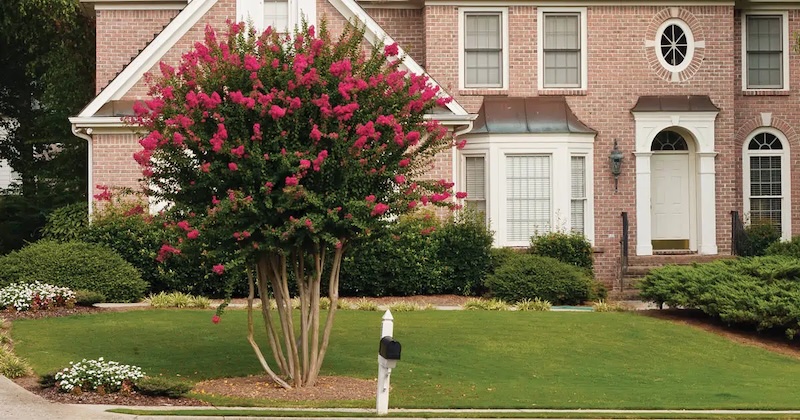Crape myrtle, Lagerstroemia indica, is a popular deciduous tree or shrub commonly planted in the southern United States. Grown for its remarkable display of flowers and beautiful form, crape myrtle is hardy to zones 7-10 and can grow from 4-20 feet tall and wide. It produces long-lasting spikes of flowers in shades of pink, white, or purple from early summer to fall. Crape myrtle also has ornamental peeling bark for year-round interest. This shrub makes a spectacular focal point and can be planted in containers, borders, hedges, cottage gardens, and pollinator gardens.
Crape myrtle needs moderate moisture in well-drained, slightly acidic soils. Once established, these plants are both drought and heat tolerant. Crape myrtle needs full sun for best growth and flowering. Check with your local extension office before planting crape myrtle, as it can be invasive in some areas. While crape myrtle is relatively shallow-rooted, it can spread extensively via its seeds. If these seeds germinate, they can crowd out native plants and other plants in your garden.

Shrubs To Plant With Crape Myrtle
To create a formal garden, grow crape myrtle with boxwood. When planted around crape myrtle, boxwoods can create an excellent hedge or living fence. Additionally, the evergreen boxwood foliage provides spectacular winter interest when paired with crape myrtle’s ornamental bark. Crape myrtle can also be planted with flowering shrubs like hydrangea and spirea. These shrubs make an eye-catching border with their overlapping bloom times and beautiful flowers. Consider planting crape myrtle and dogwood (Cornus kousa and Cornus florida) together for plenty of blooms. Together, these large shrubs can provide shade for numerous understory perennials and annuals.

Perennials To Plant With Crape Myrtle
Crape myrtle provides plenty of shade for perennials that don’t need much sun. Some of the best shade-loving perennials include hostas, Solomon’s seal, and coral bells, which all feature interesting foliage. Add a flowering ground cover like lily of the valley or woodland phlox (Phlox divaricata) to fill empty spaces and suppress weeds.
Beyond the shade of crape myrtle’s canopy, sun-loving perennials can grow and complete your garden. Extend the blooming season with bulbs such as tulips and daffodils. Add textural interest to your garden by planting bearded irises, ornamental grasses, and sedges. The sword-shaped leaves of bearded iris and fine-textured foliage of ornamental grasses will complement the stately, multi-trunked form of crape myrtle. Lastly, add a hardy hibiscus hybrid for its large flowers that bloom around the same time as crape myrtle.
Annuals To Plant With Crape Myrtle
Attract pollinators to your garden by planting verbena and lantana with your crepe myrtle. These low-growing, sprawling annuals are favorites of bees and butterflies. As an added bonus, these plants will act as colorful, long-blooming ground covers in sunny spots. Grow shade-tolerant annuals such as impatiens and begonia beneath your crape myrtle. Plant them in dappled sunlight for vibrant flowers.
Best Companion Plants For Crape Myrtle in Containers
Crape myrtle is stunning when planted alone in a large container. However, this shrub also makes a great thriller plant when potted with other plants. Place it in the center of the container to make it the focal point. Plant a shallow-rooted annual, such as alyssum, around the base of the crape myrtle for long-lasting flowers. Next, choose a spiller plant like English ivy or lysimachia for lush foliage that trails down the sides of the pot. Dwarf cultivars of crape myrtle are best for containers, which should be at least 6 inches wider than the rootball to comfortably accommodate all plants.

Plants Not To Grow With Crape Myrtle
Do not plant crape myrtle under the shade of large, overhanging trees. Crape myrtle needs around 6 hours of sunlight per day for best flowering. Additionally, too much shade can lead to issues like powdery mildew and other diseases. Crape myrtle has shallow roots and delicate bark, which are easily damaged by disturbance or injury. Do not plant it too close to plants with aggressive root systems, and avoid planting anything closer than 12-15 inches from the base of the trunk.
Best Plants To Grow With Crape Myrtle
The best plants to grow with crape myrtle prefer full sun and moist, well-drained soil. Create an elegant formal garden with boxwoods for year-round interest. Grow crape myrtle with flowering shrubs like hydrangea, spirea, and dogwood for an impressive floral display. Underplant crape myrtles with shade-loving perennials and annuals such as hostas, coral bells, Solomon’s seal, lily of the valley, woodland phlox, impatiens, and begonias. In sunny spots, use crape myrtle as a specimen plant surrounded by bearded irises, ornamental grasses, lantana, hibiscus, and verbena for added layers of color. In containers, use crape myrtle as a thriller plant with spillers such as lysimachia, alyssum, and English ivy.
 |
Lauren Youngcourt - Published 12-08-2023 |
